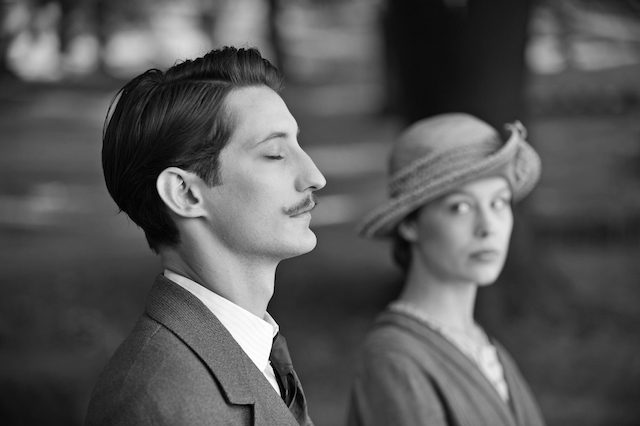‘Goodbye to Language’ You haven’t lived till you’ve seen Jean-Luc Godard titles in 3-D. Godard’s films, especially the ones made after his accessible-ish pre-1967 period (though those too), can seem intimidating, as though they were impenetrable puzzles only Mensa inductees could solve. But each one is about lots of things; there’s no single key to unlocking them, and they’re not, as it were, puzzles. They can even be enjoyable in a purely surface-level, even superficial way. Digging into them yields untold riches, but you can get loads out of just going along for the ride. “Goodbye to Language,” his latest, inarguably demands three or four, or maybe six or 10,000, viewings; perhaps the most substantial current piece written on it comes from the greatDavid Bordwell, who did just that. And yet even a single viewing can yield riches. Let’s start with at the beginning: those aforementioned titles. This is Godard’s second 3-D film and first feature, after his contribution to the anthology picture “3X3D.” He kicks this one off with the giant, colorful words that pepper most of his work — those extra stabs at commentary and wordplay (or both) he crams into his already overflowing works. Seeing them in stereophonic is transcendent; you’re seeing something you’ve been watching your whole life — or that its maker has been doing for six decades — given a simple, elegant new lease on life. Is this his “Breathless” for 3-D? Not really. It’s not so much a reinvention of the form — its portentous title be damned — as a typically playful, reliably cranky missive with some extra oomph. It’s not Year Zero; Godard is building on some of the experiments he’s been tinkering with in “Film Socialisme,” “Notre Musique” and “In Praise of Love” (if not his entire body of work). Even for late Godard there’s little plot. There are two sets of lovers: one in the first half, the other in the second. They share some incidents: an act of violence, a ferry ride, an old movie on the TV, casual, gnomic utterances, casual hardcore nudity. (This bifurcated, rhyming structure is a little like Hong Sang-soo, though only superficially.) There’s also a dog, who almost certainly has the most screentime. The usual Godardian suspects are present and accounted for, notably the tossed-off philosophy that isn’t intended (unless it is!) to tie this all together into a rigorous term paper. They’re more like random thoughts he slipped in as they were came to him — more stuff he wanted to cram into an overflowing suitcase. “Camera in Russia means prison,” someone says, prompting a treatise on Russia’s connection to Europe. At some point it’s pointed out that television was invented the same year Hitler was democratically elected. Coincidence? Maybe. You never know how Godard wants us to process these, or if they’re just foodstuffs for thought. But this is, the title says, about language, meaning we should be looking at the visuals and listening to the aural track. There’s always been more than a faint suspicion that Godard is messing with us — denying us expected cinematic pleasures while giving us new ones; interrupting music for loud noises or dialogue, then restarting it. In 1987’s “King Lear” he embraced Dolby sound by cranking up loud noises on parts of the soundtrack, so that out-of-nowhere bird squawks cropped up at eardrum-shattering levels. (That film also found Godard himself narrating with what sounded like peanut butter in his mouth.) He does that a bit in “Goodbye to Language” too, only here it’s sometimes used for the scatological. This is the smartest film ever to feature tons of farting (from naked hotties and less hot older naked men), plus loud pooping, all in between fits of brainy philosophizing. But his big obsession is with the 3-D. Sometimes he gives us pure pleasures, as with those titles, or when that dog — super, super adorable, this dog — crams his nose into the lens and thus into our faces. But he also loves playing with the technology’s imperfections. Sometimes he puts an object or a person in the near foreground, which really messes with how the eye processes 3-D depth. Even more memorable/traumatic are the handful of times he lays one 3-D image on top of another then has them pan different ways — as close to having your eye sliced with a razor as you can get. (This movie sometimes hurts to watch, in a great way.) There’s a lot to unpack here, but even if you’re just staring slackjawed, like an idiot who will figure this all out later, it can be a lot of actual, honest-to-god fun — and usually very funny.
Director: Jean-Luc Godard:
Stars: Heloise Godet, Kamel Abdeli
Rating: NR
3 (out of 5) Globes
Review: Jean-Luc Godard’s ‘Goodbye to Language’ has 3-D, loud pooping and a cute dog
Follow Matt Prigge on Twitter@mattprigge


















